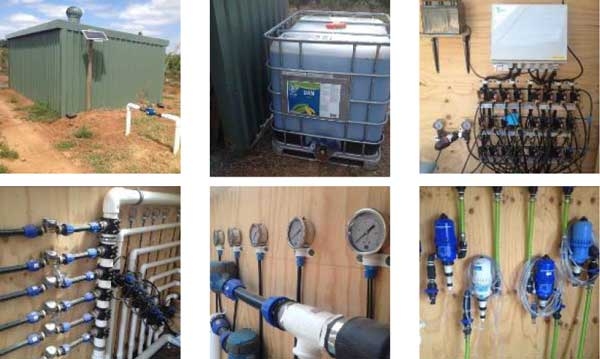Irrigation and fertigation management (continued from last issue). Irrigation sub-mains installed to each experiment provide the ability to control water (and nutrient) inputs to meet the specific requirements of species/cultivar and experimental treatment design.
All trees are irrigated using dripper tape positioned along the tree line.
Emitter (pressure compensated) spacing is 0.5 m with a flow rate of 1.6 L/h. Water flow meters are used to monitor irrigation inputs.
Irrigation water is applied daily.
Irrigation amount (run-time) is based on a crop water use model using weather data and a crop coefficient adjusted for tree canopy size.
Irrigation inputs for seasons 2013–14 and 2014–15 were 4.6 and 2.6 ML/ha, respectively. The main difference in irrigation supply between the two seasons was due to rainfall.
Figure 3 shows irrigation and fertigation infrastructure used to schedule and monitor irrigation inputs and apply nutrients. The fertiliser program aims to meet crop requirements with nutrients applied by fertigation.
Industry advisory committee
An industry advisory committee guides the project’s research, orchard management and communication activities.
Linkage projects with national and international research partners are being developed to utilise the resource of field laboratory.
The project team will integrate and adapt emerging technologies and tools to improve production outcomes.
Examples of non-destructive tools being used to measure fruit quality and canopy condition include: fruit maturity (DA meter), fruit sweetness (NIR meter), fruit size (digital callipers), canopy size (radiation interception) and crop water stress (UAV–thermal imagery).
2015–16 season
The 2015–16 season will see the first crop harvested from the orchard.
The effect of low, medium and high crop load treatments on peach and nectarine applied to the different canopy training systems (Figure 1, and Table 1—Experiments 2a, 2b, 2c and 2d [see Tree Fruit Sept 2015]) will guide science-based production practices for growers to effectively manage tree establishment and growth.
Producing consistent yields of uniform, high quality fruit will increase the competitiveness and viability of the Australian stone fruit industry.
During the coming seasons, DEDJTR scientists will be organising field tours for growers, consultants and other industry representatives.
Information on the project and field visits are posted on the Horticulture Industry Network (HIN) website www.hin.com.au/projects/stonefruit-field-laboratory
This project is part of Profitable Stonefruit Systems Project, supported by Summerfruit Australia Limited and Horticulture Innovation Australia. The Agriculture Division of DEDJTR established the new experimental orchard at Tatura, near Shepparton, Victoria.
See this article and author contacts in Tree Fruit Oct 2015






















